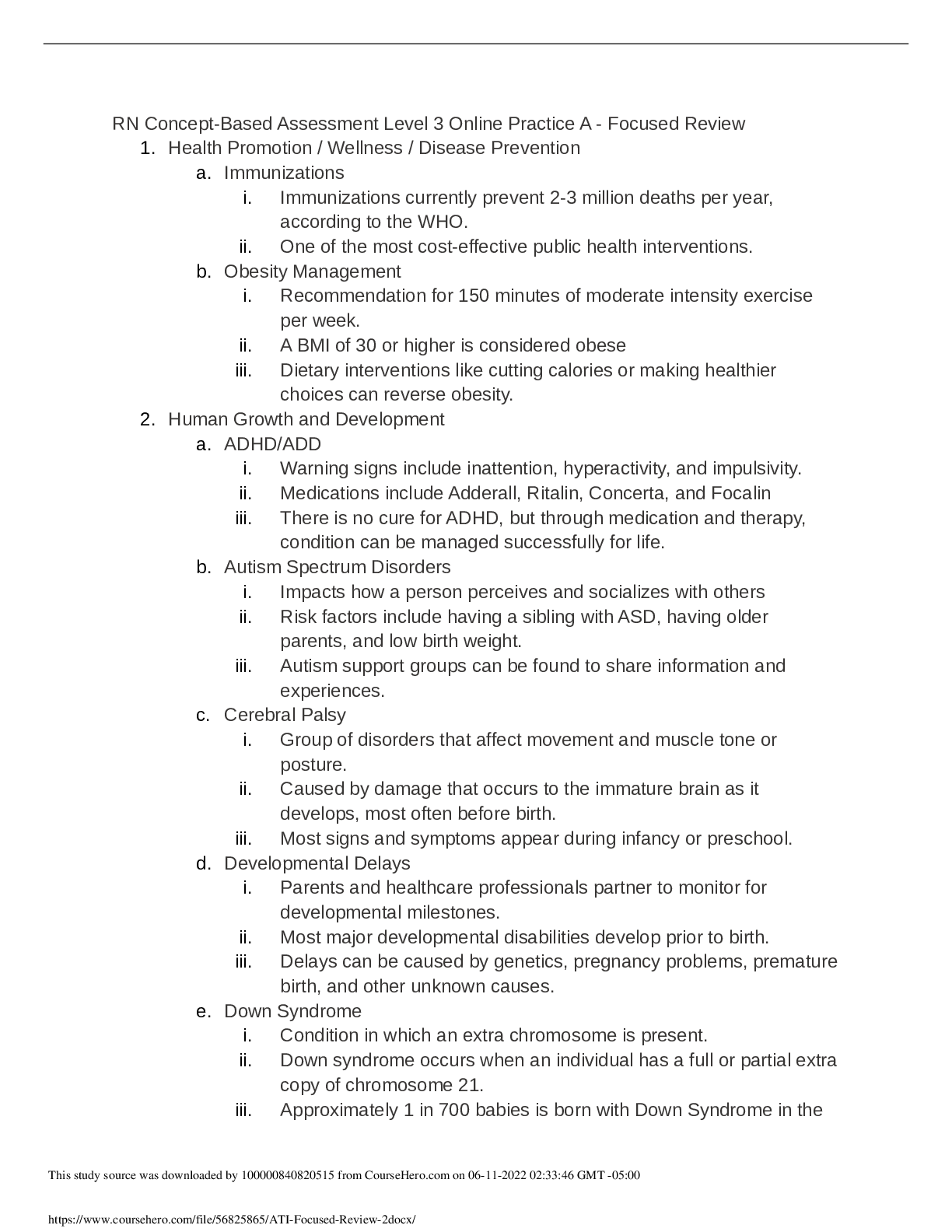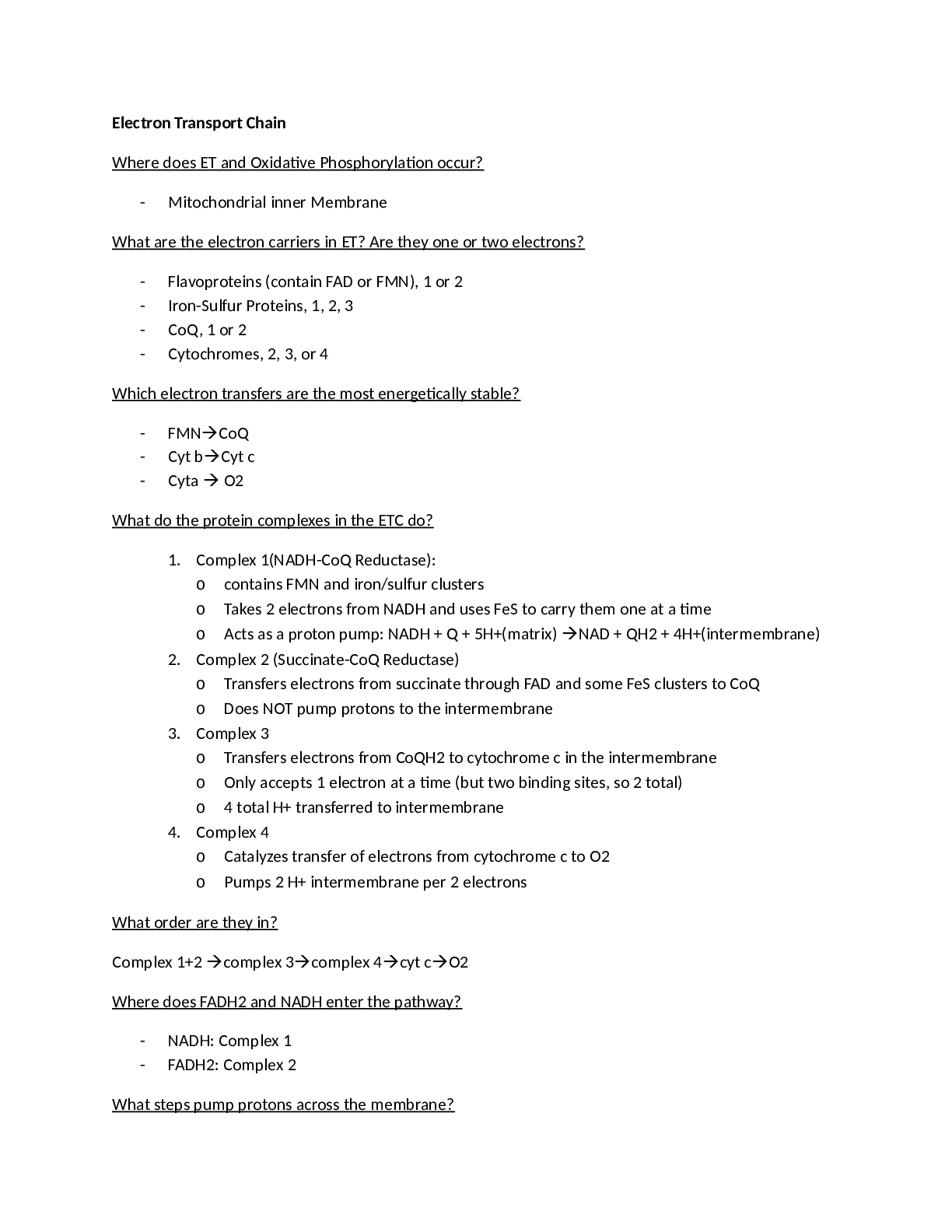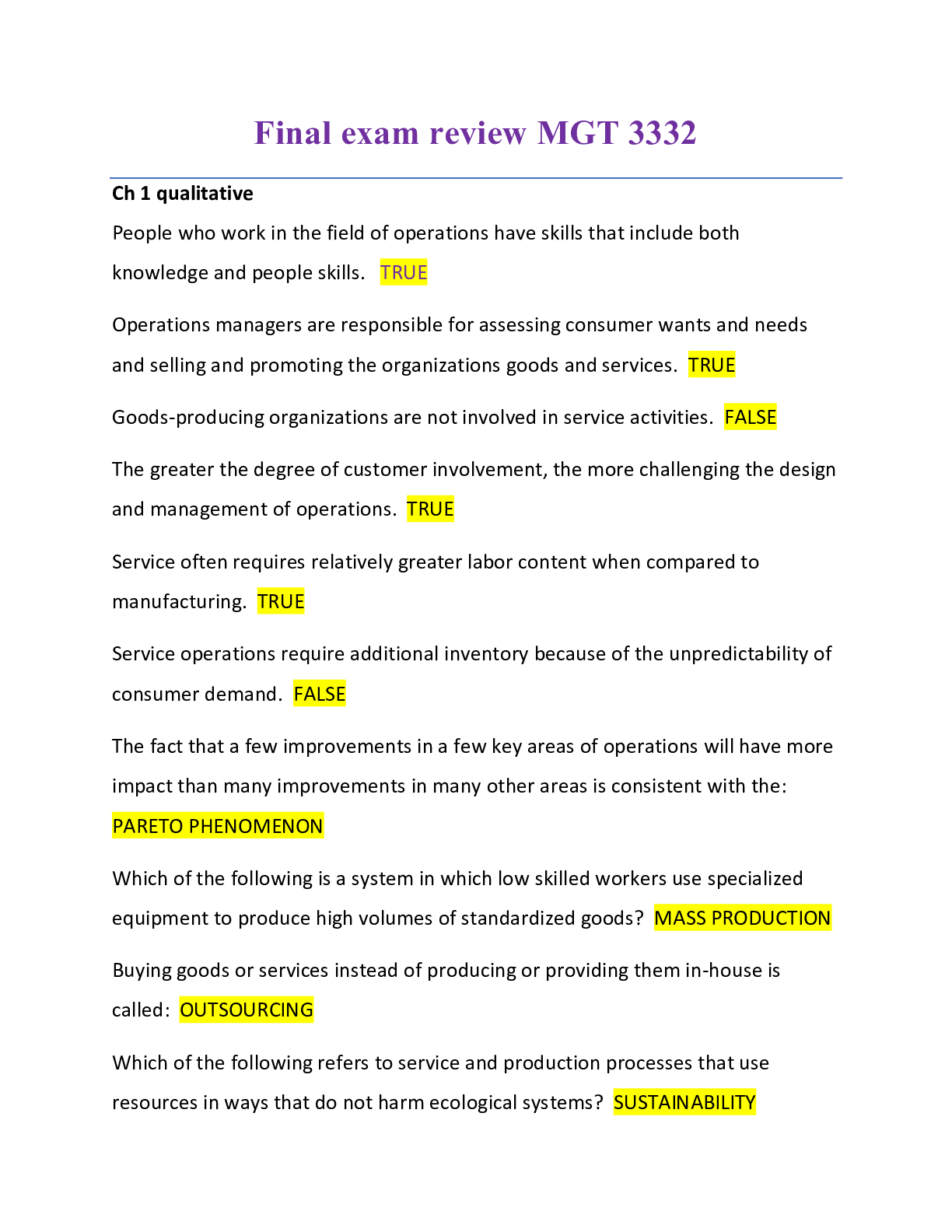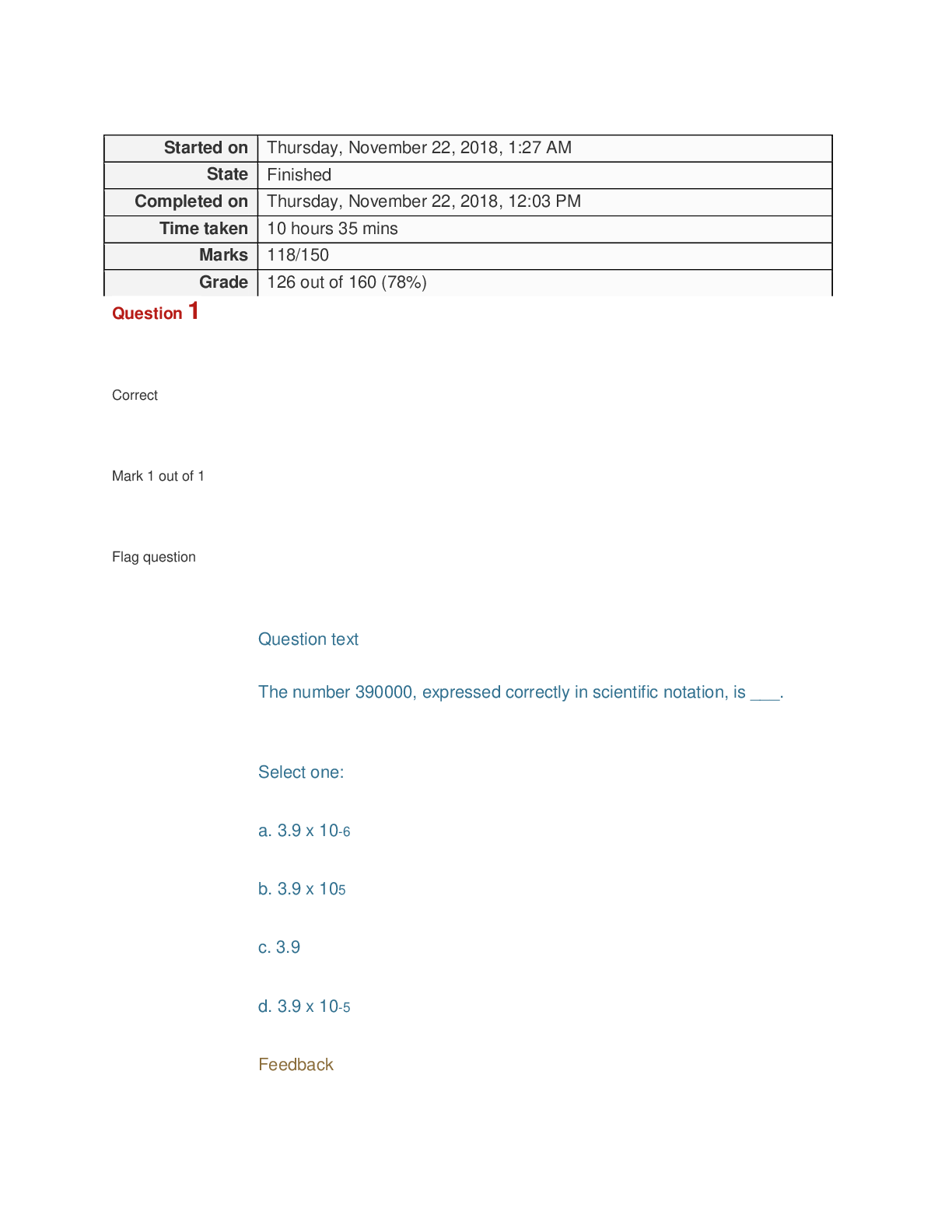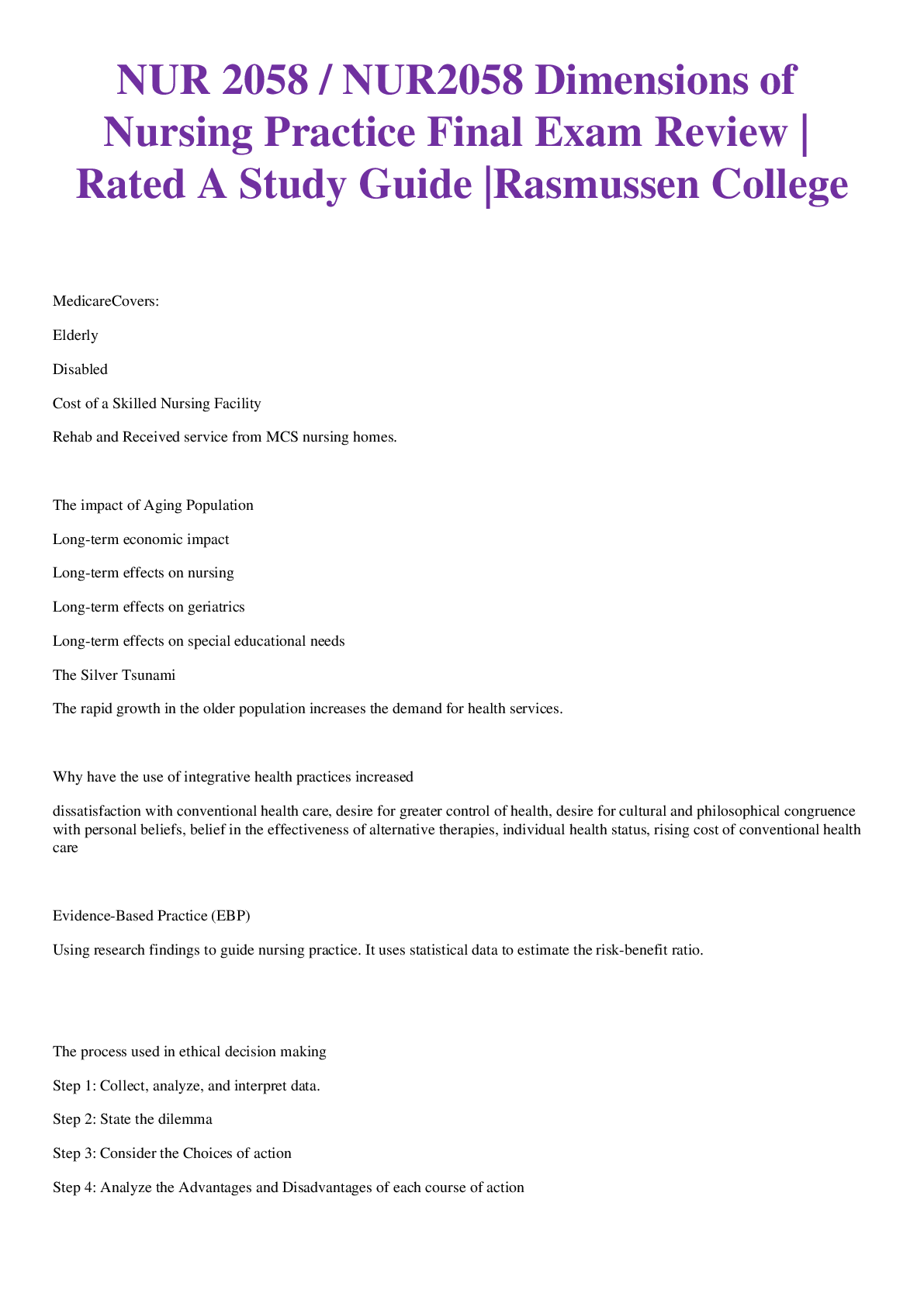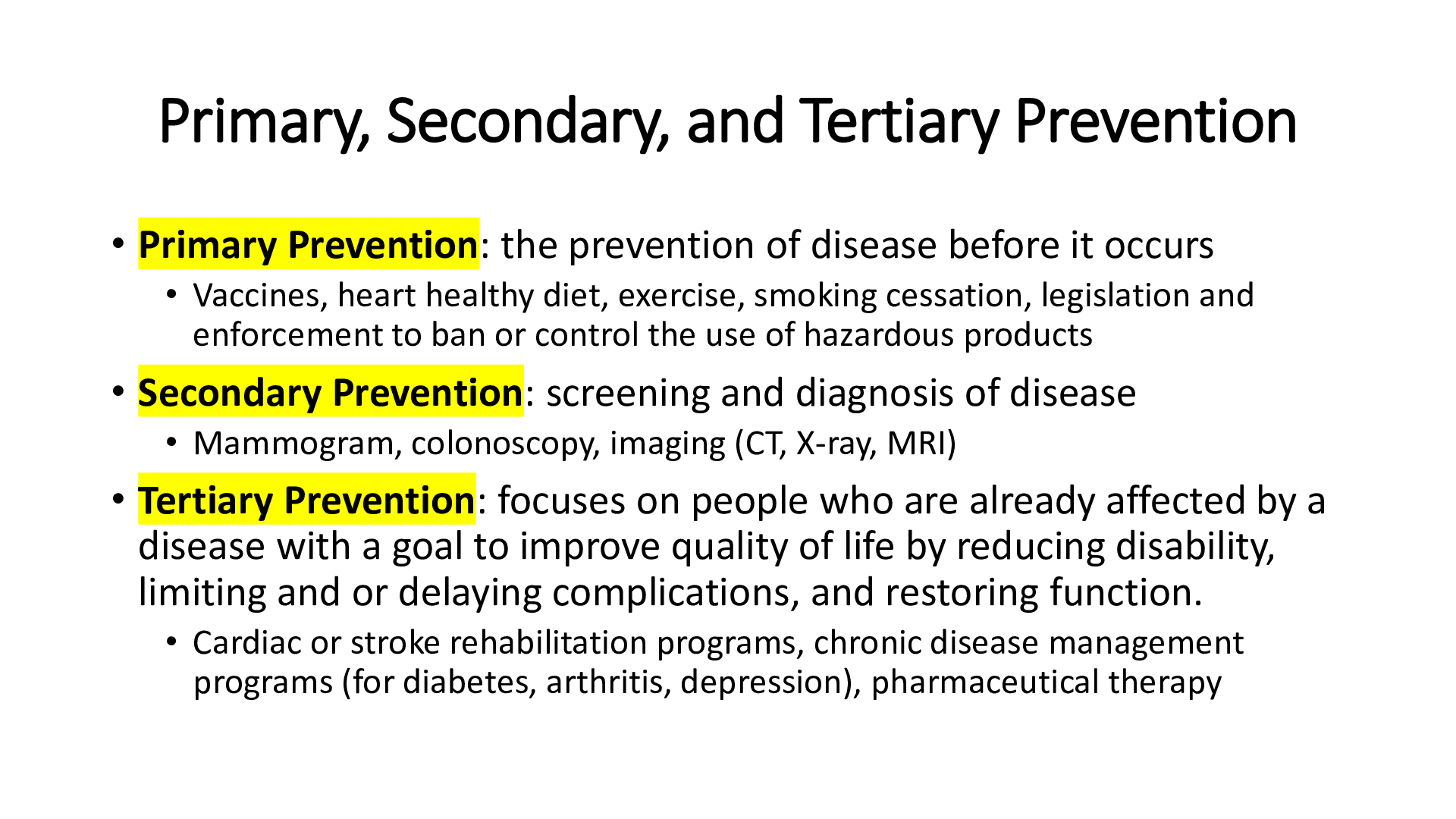*NURSING > EXAM REVIEW > NURSING 3365 Exam 2 review. (All)
NURSING 3365 Exam 2 review.
Document Content and Description Below
NURSING 3365 Exam 2 review. Exam 2 Review (Refer to course map) Beta Blockers Cardioselective blocks beta 1 and non-cardioselective blocks beta 1 and 2 Atenolol blocks B1 only (cardioselective... ) and propranolol (non-cardioselective) blocks B1 & B2 For what conditions are beta-blockers used for Beta-blockers slow HR and decrease force of contraction to make it easier for heart to work, but there are some vasodilation, so there can be some hypotension. Make sure BP is ok, and resting HR is between 60-100. What do you do before you pick up the phone and call the doctor? Assess the patient, you must finish your nursing assessment. When you are looking at a test question, you will have some information in the stem of a question. There may be some assessment data in the stem of the question, but then look down at the choices and if you can choose one of those things that is completing your nursing assessment, that’s what you need to do. Before we can do ISBAR, we need all the information. You got to have all vital signs completed, all the subjective data, asking them questions. A question might not involve vital signs, but a laboratory value that you want to know before you call the doctor What are the two indications that professor laird gave for epinephrine? Anaphylaxis and cardiac arrest If somebody must have allergy testing or cardiac stress testing, what do we need to have them understand about beta-blocking therapy? The physician needs to take them off beta blockers for 48 hours before they have allergy testing and cardiac stress testing. It’s not hypotension, if they are beta blocked out, and they get anaphylaxis during allergy testing process or cardiac arrest during stress testing on treadmill, how well will the epinephrine work if someone is on full dose beta blockers. The idea is that they have the conversation with their prescriber and the prescriber can put them on something for 48 hours while they are off the beta blocker because we never want a patient to stop the beta blocker cold turkey, and the reason for that is they might have a rebound elevation of BP or may have rebound of cardiac angina or cardiac type chest pain. IV doses versus PO doses of beta-blockers- Which is larger and why? Beta-blockers have a high or large first pass effect. IV dose would be smaller than the PO dose. What are significant drug interactions (beta 1 blockers, digoxin, and calcium channel blockers) They all slow the heart rate. We have to be careful with a patient on two of those drugs together. All have that common problem. Alpha 1 blockers – alpha receptors are in the arterials of the skin, mucous membrane, and organs. Alpha 1 blockers are powerful vasodilators. So, tell the patient to change positions slowly. We tell the patient to take them at night to limit orthostatic hypotension. Example is especially if we are treating a male patient with an enlarged prostate gland, they can’t empty bladder properly, so they go frequently, maybe 3-4 times at night. If they are on the alpha blocker, they are going to be able to completely empty their bladder and so they won’t have to jump out at night. They will get a good night’s sleeping and won’t be at risk for orthostatic hypotension because they are asleep. Orthostatic hypotension can lead to fainting or dizziness, which can lead to falling If BP drops, what must happen to HR to maintain cardiac output? HR increases Doxazosin (Cardura) and tamsulosin (Flomax) are alpha 1 blocker prototypes Doxazosin can be used in a male patient that has hypertension and BPH Tamsulosin can only be used for BPH Alpha 2 Agonist Alpha 2 Receptor is a Pre-synaptic receptor – stimulation causes the NE to be taken back up into the presynaptic neuron. Thereby preventing the release of norepinephrine from the CNS to the systemic circulation. – helps reduce circulating norepinephrine – therefore, helps lower BP. Often added as third or fourth drug in line to treat hypertension. Often an Add-on Prototype is clonidine Removing norepinephrine will get reduced vasoconstriction, decreasing or lowering BP Lipid-lowering drugs Statin drugs are the most common drugs given for elevated total cholesterol and reduced the bad cholesterol, the LDL (bad), the HDL (good), and the blood fats, the triglycerides. Statins are taken by millions of people and they are safe, but occasionally people will muscle pain (myalgia) (rare), so they will be taken off the statin. Occasionally, they will have very severe muscle pain called Rhabdomyolysis due to breakdown in the muscle and release of muscle protein (myoglobin) and the myoglobin blocks the tubules in the nephron, which can lead to renal failure. CYP450 inhibitors and grapefruit: A patient who took a grapefruit juice while he was on a statin and didn’t know about drug interaction, developed severe muscle pain, muscle breakdown, leading to renal failure and died. CYP450 inhibitors are going to make fewer drug-metabolizing enzymes and you are going to have a higher free drug level, putting you more at risk for toxicity. CYP450 inducer will tell the liver to make more of those enzymes and the blood level will go down, creating a lower drug effect. Therapeutic effects of statins Prototype is atorvastatin (Lipitor): reduced LDL cholesterol and triglycerides, and increased HDL We usually have the patient fast before we give lipids Fibrate drugs like gemfibrozil are usually given to reduce the triglycerides, but are not recommended anymore, but exam might not go over it. Niacin (Vitamin B3) in high doses reduce the triglycerides, but even the long acting version will cause flushing of skin, itching, and burning. We usually tell patients to take aspirin 30 minutes before taking the niacin to reduce the flushing. Bile acid sequestrants won’t be going over (have a lot of gastric side effects) Anemia is not on Exam 2 Ace inhibitors – prototype is lisinopril (Zestril): angiotensin converting enzyme inhibitors Prevents the formation of angiotensin II Used for hypertension and angina, heart failure. Blocks the effects of aldosterone, so one of the side effects can be hyperkalemia Adverse effects: Ace inhibitors can cause in some patients a dry cough, reduce afterload, and can cause hypotension. So we teach our patient to change position slowly ARBs (angiotensin II receptor blockers) – prototype is losartan (Cozaar) Side effects can be hyperkalemia as well. ARBs are blocking the action of angiotensin II Ace inhibitors and ARBs are contraindicated in pregnancy and lactation REVIEW DRUG TEMPLATES Calcium Channel Blockers Dihydropyridine – D for dilate Prototype Nifedipine (Procardia) is used only for its vasodilation properties, so we will see the extended release Procardia used in some patients with hypertension and then there are others of its cousins that are used in neurology. Nifidipine is a dihydropyridine, used for vasodilation. Non-dihydropyridines – N for nodes Verapamil (Calan, Isoptin) and Diatiazem (Cardizem) are the two prototypes They are used for hypertension and vasodilate, but the other useful property is that they can slow conduction through the AV node and if they slow conduction through AV node, they can be used for things like Atrial fibrillation or very rapid tachycardia to slow down HR when that’s necessary. All Calcium channel blockers, if we block calcium influx into smooth muscle, we are going to have relaxation, so in a blood vessel, there will be some dilation, in the bowel, constipation. All calcium channel blockers can cause constipation, but verapamil is particularly bad about that. We also have stored calcium in cardiac muscle, so we give calcium channel blockers not only for hypertension, but also for atypical or Prinzmetal’s angina (vasospatic angina). Atypical angina occurs at rest, often at same time of day, often at night, related to coronary artery spasm. Diuretics Don’t worry about lithium right now. Think about assessments that are required for anyone who is on a diuretic, what are you doing with a diuretic. You are producing urination, which is reducing preload. Ultimately, there will be less filling in the heart, reducing some of the cardiac output, and so you want to monitor kidney to see if kidney is getting enough blood supply. If not, the creatinine goes up, it is going to slow the clearance of drugs. Loop diuretics are more powerful than thiazide. They will pull a lot of water and sodium off and waste a lot of potassium. So, if they are on Lasix, they need to be on some potassium replacements or supplemental potassium. Before you give the patient Lasix, especially IV in the hospital, your nursing assessment is determining what the potassium level is. If it’s too low, you must ask an order to be able to replace the potassium. Even if the patient is on the potassium supplement, maybe the lab comes back, and the level is too low, you have to still call the doctor before you give the Lasix, especially IV, because if you give it, when the potassium is already too low, you can cause significant cardiac dysrhythmias. If you want to know that you are getting benefit out of the diuretic, what nursing assessment gives you the best assessment of the therapeutic effect of the diuretic? Daily weight, the weight of the patient is what tells you that the diuretic is working. If they take it at home, they are instructed to weigh themselves every day, same scale, same time of day, and to report if they are gaining 2.2 lbs a day or 5 lbs a week. In this case, they are holding on to fluid because 2.2 lbs is 1 kg and 1 kg is 1 liter of fluids. Loop diuretics are powerful, so give them slowly. You can cause ototoxicity, which means ringing in the ears, hearing loss, and older patients already have hearing loss, and it can be permanent. If we are wasting potassium, pulling off a lot of fluid, and a lot of potassium, you can get cardiac dysrhythmias related to low potassium. Hyperkalemia can happen if somebody was getting too much replacement potassium. But Loop diuretics waste potassium. Both hypo and hyperkalemia can cause weakness, twitching (patient complaining of palpitations) because you need potassium for nerve conduction and muscle contraction. If someone is on high dose Lasix for several days and you try to get them out of bed, they will complain of weakness in legs because it may be related to low potassium, hypokalemia. Thiazide diuretics are gentle diuretics and in very low doses, they are just used for antihypertensive effect. Can be used low dose by themselves or added to another drug. Sometimes we use an ace inhibitor combined with a thiazide diuretic in a very low dose, and we’re just getting hypertensive effects out of both. We can increase both and not only get reduction in BP from thiazide but get diuretic effect as well. Thiazide diuretics can cause hypokalemia, hyperglycemia, hypercalcemia, hyperuricemia (gout). Potassium sparing diuretics hold onto potassium. Sometimes given alone if somebody has an abnormal collection of fluid in the abdominal cavity called ascites and can be part of heart failure, kidney failure, or liver disease. It is sometimes added when somebody has a loop diuretic because it wastes potassium, and so they are put on a potassium sparing diuretic to slow down that potassium loss. spironalactone (Aldactone) and triamterene (Dyrenium) are the two prototypes All these drugs have an effect on the adrenal gland. Spironalactone messes with an enzyme that converts estrogen, so men can develop breast tissue or gynecomastia. Triamterene can cause kidney stones and a type of anemia because it blocks folic acid. We need folic acid, vitamin B12, and iron to make RBCs. Without folic acid, we can get megaloblastic anemia. Megaloblastic anemia is where RBCs are large. Patients can get a skin rash from thiazide or from Lasix Hypokalemia – low potassium We need potassium for nerve conduction and muscle contraction, so normal potassium is absorbed in the first part of the duodenum, the small bowel. If the gut works, we want to use it, so it would be better to replace potassium by mouth, but occasionally, we must use IV. If given IV, it’s mixed in a small bag and given on an infusion pump, and give it over hours, not minutes into a large vein (small veins are uncomfortable). If by mouth, most oral potassium tablets are big horse pills, so hard to swallow. There is one that dissolve in a cup with water like Alka-Seltzer. There are both immediate and extended release tablet. Can I crush or chew an extended release tablet? No So, you can’t crush or chew an extended release potassium tablet Can you put an extended release potassium tablet down a tube? No, you can’t crush it up, mix it with water, put it in a syringe, and put it in a tube What is the risk for patient taking digoxin and diuretics if they develop hypokalemia? Digoxin and potassium both compete for the receptor, the potassium ATPase pump on the cell. If you have hypokalemia, you allow more binding of digoxin at that receptor before more digoxin gets inside the cell and predisposes the patient to digoxin toxicity. My patient took an overdose of digoxin, so he’s already dig toxic with dig level of 6. Why do I have hyperkalemia? Because of the Potassium in the blood, digoxin has taken all those binding sites and because there’s too much digoxin, it won’t let potassium back inside the cell during repolarization, so hypokalemia will predispose digoxin toxicity because it lets more digoxin get in, when you get when digoxin toxicity and that digoxin level is very high, all those binding sites are taken up with digoxin and it won’t let the potassium back inside the cell, repolarization, therefore dig toxicity can cause hyperkalemia. Digoxin Digoxin is not the first drug we would choose for heart failure. It is used for people with chronic, symptomatic, uncompensated heart failure. It is a drug of last resort because there are so many better drugs available now. We don’t want patients substituting tablets for capsules or vice versa with digoxin because there is different bioavailability for those different formulations. We don’t want them swapping formulations and it can happen when people share formulations, so it’s important to let them know it’s very dangerous We sometimes give digoxin IV, but we give it very slowly because it is a narrow therapeutic index drug. 0.125-0.25 for the daily doses. 0.5 mg is where greater risk of toxicity occurs. (High alert drug?) Digoxin works, once it gets inside the cell, it releases stored calcium and allows actin and myosin fibers to come together to make a good cardiac contraction. It slows the HR – negative chronotropic effect It increases force of contraction – positive inotropic effect It slows conduction through the AV node – negative dromotropic effect When we measure the blood level, the blood level is measured in ng/ml. The dose is given in mg like 0.125 mg a day or 0.25 mg a day. But when you draw a blood level, you do not want to see the blood level any higher than 2.0 ng/ml (?) There is a lot of drug interactions Beta blockers, calcium channel blockers, and digoxin all slow the HR Remember, your job is to finish your nursing assessment before you call the doctor, understand that your nursing assessment before you give digoxin is to check the apical HR. You do that by putting the stethoscope on the chest and counting the HR for one FULL minute. You do that because in atrial fibrillation, the heart rhythm is irregular and if you try to take the pulse down at the wrist, you won’t capture all the beats. If the apical HR is less than 60, that’s your nursing assessment, and you hold the drug and call the doctor. There are early and later signs of digoxin toxicity. Early on, for somebody who is mildly toxic may complain of a GI upset. They are off their food, anorexic, kind of nauseated, may vomit. We don’t want them to have hypokalemia because they will have abnormal cardiac rhythm. Patients might feel like they’re skipping some beats, or their heart is pounding, “I’m having palpitations.” If they are hypokalemic, they will say something like their muscles are weak. Early signs of digoxin toxicity are they don’t feel well or malaise. GI symptoms like anorexia, possibly vomiting, nausea or look for hypokalemia. Later signs are worsening of cardiac dysrhythmias and visual color changes like yellow color changes. If somebody has very mild digoxin toxicity, the doctor might just stop the drug and wait for the level to come down. Older adults are more likely to be put in the hospital because they are at greater risk for toxicity and for the bad things that can happen when they are toxic. If it’s mild, doctor stops drug, monitor blood level, give them IV fluids, something for nausea, and just watch them and make sure nothing else happens. If it is very severe, there is a drug called digibind or digoxin immune fab, monoclonal antibody given for very high dig levels. High dig levels, cardiac dysrhythmias, hyperkalemia, you would give the digibind, it binds up the digoxin and inactivates it. In Loop diuretics, you’re wasting a lot of potassium, so you’re predisposing the patient to dig toxicity. Don’t wait till later symptoms appear. If you recognize somebody on digoxin is not feeling well, nauseated, off their food, you would stop the drug and call the doctor. If the HR is less than 60, you stop the drug and call the doctor. You do need to watch the creatinine because if it goes up, the patient is not going to be able to clear digoxin and that’s another way they can become dig toxic. Most of these people are not in the hospital, so we must teach them how to take their own pulse, and we teach them to put two fingers at the angle of the jaw and measure all the beats. We need to tell them what to report and what kind of symptoms they should report. If they don’t feel well, nauseated, don’t like eating, maybe palpitations, leg muscles are weak. These are all indicative of early cardiac problems or early digoxin toxicity, so they need to know they shouldn’t be putting up with that stuff. Antianginal drug: Nitroglycerine is prototype Nitroglycerin comes both sublingual (most common) and in various formulations (look back at forms and things with an asterisks), rapid-acting, intermediate-acting, and long-acting Sublingual nitroglycerin is given under the tongue. It goes through the mucous membrane in order to be absorbed into the bloodstream. There is a good blood supply in the mouth. IV nitroglycerin doesn’t have to be absorbed because we are putting it directly into the blood Nitroglycerin patch is slowly absorbed through the skin into the bloodstream You have capsules or tablets that must be given once or twice a day. Do they go through a first pass effect? Yes Nitroglycerin is a very powerful vasodilator. It vasodilates arteries and veins and it’s very good at vasodilating coronary arteries. In a sense, it is a pro-drug because it must be converted from nitrate to nitric oxide by sulfhydryl groups. The body must regenerate those sulfhydryl groups overnight, so we tell the patient who is on a nitroglycerin patch to take the patch off at night and put another one in the morning, so that gives the body an 8-12-hour drug free interval to allow it time to regenerate those sulfhydryl groups. The same if they are taking the capsules or pills. If they must take a pill or capsule twice a day, we will tell them not to take the second dose after about 5:00 at night to give the body that 8-12-hour drug free interval. If a patient comes in and say “well, I’m having to take my sublingual nitroglycerin way more than you said I would have to take it. You put this patch thing on me, I don’t think it’s working.” What’s the problem? They didn’t take off the patch. They developed tolerance? Patch, tablets, and capsules are for prevention. Long -acting What is used for chest pain that is happening now would be sublingual nitroglycerin How many doses of sublingual nitroglycerin can a person or patient take, or a nurse administer and at what interval? Maximum of 3 doses at an interval of 5 minutes If a patient takes the first nitroglycerin, and the pain is not immediately relieved like in 1-2 minutes, what do they have to do? CALL 911 If you are on the med surg floor and you must give the patient nitroglycerin because they have chest pain, and you give them the first nitroglycerin under the tongue. 5 minutes later, they are still complaining of significant chest pain that has gone from a 10 to a 7. How do you know you can give the second nitroglycerin safely? The systolic BP (top number of BP) must be at 90 or above. If it’s below 90, you can’t give the second nitroglycerin. What we are trying to do is maintain an adequate mean arterial pressure, enough to perfuse the brain, the coronaries, the kidneys, and all those vital organs. There are three types of angina. Classic effort angina: anytime there’s effort, there is chest pain Atypical or Prinzmetal’s angina (Vasospastic): Patient doesn’t have plaque in their arteries. For some reason, their coronary arteries are spasming. Calcium channel blockers are used in this scenario. Can occur at rest, sometimes at the same time of day or wakes the patient up at night. Unstable angina: When patient has more frequent and more severe episodes of angina, which may tell you the patient is going on to have an MI (ACS). Something’s change, it’s getting worse. This is when we call the ambulance, which ANOM is used. If they still have pain in the ER after the maximum dose of nitroglycerin, doctor may want to give them IV nitroglycerin, a nitro drip. What are they going to ask the patient before they give them a nitroglycerin drip? They are going to be concerned if the patient might have taken an erectile dysfunction drug (Viagra, Cialis). Some work immediately and out of the system for 24 hours, but some last for 48 hours. They work differently from nitroglycerin, but they are powerful vasodilators (which is why they work). The doctor would need to know if the patient has taken an ED drug in the last 24-48 hours. Sometimes, patients are given nitroglycerin ointment in the hospital. You squeeze it out like toothpaste on a piece of paper on a grid. It is ordered ¼ inch every 12 hours, put it on clean, dry skin, stick in place with sticky tape. WEAR GLOVES prior to applying it or else you get vasodilation as well and get a headache. If patients can’t afford the capsules or pills or is poor, doctors might send them home with the leftovers of the nitroglycerin paste. You would have to tell the patient or the caregiver to wear gloves upon applying the paste. Whenever you put something on the skin with adhesive on it, whether it’s a drug patch or any kind of patch like a nitroglycerin patch, people can have a skin reaction to the adhesive. So even if you take a little piece of paper with the nitrobid paste with it, and you stick down with the tape. You want to rotate that site where you put the patch, so you aren’t putting it in the same place every time and the adhesive is not causing a skin reaction. When patients are given sublingual nitroglycerin as a prescription, we don’t want to give them very many because it doesn’t stay potent very long. It needs to be stored in a dark glass container with a metal cap with no cotton fillers. It has stay or kept at room temperature or cool. We don’t want them to put it in the pill organizers because we want them to be protected from the sunlight. Coagulation modifiers Unfractionated heparin that we use with the heparin protocol, to determine the difference between the standard and modified protocol. LMW Heparin: enoxaparin (Lovenox) These are powerful anticoagulants. They work immediately. The IV heparin that you give in by a continuous infusion, using the heparin protocol. So when we give IV heparin, we use our weight based protocol. We need an accurate weight in kg. The Pharmacist mix the drug. We know that heparin is a high alert drug. There are many mistakes wrong like the concentration. We always check the order with another nurse, read the label on the bag from the pharmacy with another nurse, and we use the weight based protocol to both determine what the doctor wants in terms of the standard or modified protocol, and that’s going to be determined what the condition the patient has, if they have been to the lab or not and does the doctor want the patient to have warfarin, the oral anticoagulant. If so, how many mg. We must do baseline laboratory studies before we give our bolus or before we start. When we give an IV with an anticoagulant, we are anticoagulating the patient immediately, so we are going to use the heparin protocol to know that we are going to assess the patient every shift or every hour for bleeding. We are going to report an unplanned interruption of the IV infusion, if the patient has any trauma, prevent injury. The heparin protocol will be given on the exam. In the hospital, we will see documents like this and we need to read them, utilize them, and understand them. You got a patient on an heparin drip, they are going to be anticoagulated immediately, you are the nurse taking care of the patient. What kind of toothbrush would you want them to use, so their gums wouldn’t bleed? A soft toothbrush If they are going to give them other drugs while they are on their IV infusion of heparin, would it be smart to give them all their medications by IM or SubQ injections? No, it wouldn’t be safe because they would be getting a lot of hematomas. They might be bleeding significantly. So, often times, they are very sick and, in the ICU, so the blood supply to the gastric mucosa is not good, so if we have to give injections, we are more likely to give them IV and you can put the drugs in the IV line, but in a separate heparin drip. Look over heparin protocol. Think of all the things you are protecting your patients from. Think about the correct lab test that is telling whether you are anticoagulating the patient properly with IV heparin infusion. That’s the PTT. It tells you right on the protocol where you want that to be. After you got through the first part where you have given the loading dose and started your drip, then it tells you what you are going to do to maintain the drip. It will give you the lab result down the side. The first column will you if you must repeat the full bolus or a half bolus. The second column will tell you if you must stop the drip for a while. The next column will tell you if you must change the infusion rate. If the patient is getting warfarin. There’s a different lab test. It’s the PT/ INR, the international normalized ratio, and we want it between 2-3. The INR blood test should be kept in between 2-3. If it is below 2, we got an increased risk of clotting, so we must call the prescriber. If it’s too high, there’s an increased risk of bleeding. What if that physician checked off the standard protocol, and you got the patient on the heparin drip, you got all your lab work beforehand for baseline levels, and he puts the patient on warfarin (coumadin). When can we stop the heparin drip if the patient is also on warfarin? When we have the INR at 2-3. It takes about 4-5 half-life’s to get to steady state. Warfarin has a 48 hour or 2-day half-life. 4*2=8 days. Once the warfarin (coumadin) comes to steady state, the heparin drip can come off. If someone is just on a heparin drip, or have been getting heparin, what is the antidote for heparin? Protamine sulfate (don’t have to remember doses?) What if a patient is just on warfarin (coumadin) and they are over-anticoagulated, what is the reversal agent for warfarin? Vitamin K, so we must give Vitamin K if there is an elevated INR. Warfarin (coumadin), oral anticoagulant, is highly protein bound. So if a patient is on coumadin, a very highly protein bound drug and they tell them to go to the psychiatrist because they are depressed and he puts them on an antidepressant. What might that antidepressant do to the coumadin? It increases the INR because the antidepressant is also highly protein bound and has a higher affinity for the albumin molecule. It will knock off the coumadin off the albumin molecule, which means there’s more free drug in the bloodstream. Therefore, the INR can go up because there’s more drug that can get to be effective. INR will go up, and we have to monitor that, either lowering the dose or giving some Vitamin K. Usually, we will know that they are put on that medicine, so we will check the INR more often and we’ll probably lower the dose of coumadin to compensate for the fact that the antidepressant is going to knock the coumadin off the albumin molecule. Will we tell the patient that they can never have any dark green leafy vegetables? No, we will just tell them to be consistent. If we know what they are doing, we can adjust their coumadin dose. But if suddenly, they eat dark green leafy vegetable and they didn’t tell us, we will see that the INR will go way down because the dark green leafy vegetables have vitamin K. So, they must be told to be consistent in the amount of vitamin K containing dark green leafy vegetables they’re getting. We also tell patients to read drug labels on vitamins and supplements, energy drinks, or proteins because they might not understand that those might have vitamin K. We don’t want them taking other medications without informing their prescriber. They also need to know that they must get their blood level or INR checked every month. Once we are at steady state on coumadin, they must come in once a month to have the blood level rechecked to make sure they are being appropriately anticoagulated. LMW Heparin: enoxaparin (Lovenox) It is given subcutaneously, and it is dosed in mg per kg of body weight, not units. Patient can give it at home with pre-filled syringes. If we are treating a clot, they give it twice a day. If we are giving prophylactically because they are predisposed to clotting like Brenda in the case study, they get one fixed dose per day. We give in deep subcutaneous tissue, usually in the abdomen, we rotate the site, we don’t aspirate, we apply direct pressure, don’t massage, stay 2 inches away from the belly button, don’t give it anywhere near a drain, an ostomy, anything dirty. Antidote for Lovenox? Protamine sulfate Lovenox has a 12-hour half-life. That’s why we give it twice a day. A 12 hour half life means after 12 hours, half of the dose is eliminated, so they are ready for the second dose. One of the things we talked about heparin, written in the heparin protocol, is if the platelet count drops less than 100,000/mm3 or decrease of 50,000/mm3, we need to notify the physician immediately. What do we need to be concern about if we saw that drop in platelets? HIT – heparin-induced thrombocytopenia. The drop in the platelet count is like the warning sign. It is telling you that something is wrong. What happens is that the body is making antibodies against a foreign protein, heparin, in a substance called platelet factor IV. The problem is that the antibody is also attacking normal platelets. If we do not recognize HIT and if we do not treat it appropriately, they patient can have paradoxical clotting. With heparin, we know it is anticoagulant, and we expect bleeding, and we monitor it. If they develop those antiplatelet antibodies, they can clot and so we still have to anticoagulant the patient appropriately, but we can’t use anything that will inhibit activated factor X. We can’t give them infusional heparin or lovenox, we must go lower in the clotting cascade, so we give them argatroban Argatroban is a prototype and it is an IV direct thrombin inhibitor, used to treat HIT. Remember, without activated factor X, we can’t get prothrombin to thrombin, fibrinogen to fibrin. We can’t mess with activated factor X, so we must go down to activated factor II (thrombin), then we can get inhibition of fibrinogen to fibrin. Can somebody who gets HIT can ever get heparin again? Not for a very long time, some people clear those antibodies, but we are careful with people who have had HIT. Antiplatelet drugs: Aspirin and clopidogrel (Plavix) Aspirin, in very low doses, prevents platelet aggregation because it blocks the formation in the platelet of cyclooxygenase 1 (Cox 1) for the whole life of the platelet (8-10 days or 7-8 days?). When we are giving low dose aspirin every day, we are irreversibly preventing the crop of platelets from ever making cox 1. That’s what prevents the platelets from aggregating. On the other hand, Plavix works on a different receptor, the adenosine diphosphate receptor. There are people who take aspirin in low? doses for fever reduction and pain management. Aspirin will be discussed again for drugs for pain inflammation and gout. We don’t give children under the age of 18-21 aspirin when they are recovering from a viral illness because we want to prevent Reye’s syndrome. Aspirin and Plavix, if they inhibit platelet aggregation, they can cause bleeding. If somebody takes an overdose of aspirin (acetylsalicylic acid), they will get a metabolic acidosis, which can cause rapid breathing to try to blow off CO2, ringing in ears or impaired hearing. Later, they can get some drowsiness, confusion, coma or death. Certainly, they can bleed. Aspirin can cause gastrointestinal bleeding. While we talk about people on low dose aspirin for prevention, it’s not for everyone. We must be careful of those who might be at risk of gastrointestinal bleeding or somebody who might be at risk for a bleed in the brain. After somebody has one of those ACS, if they have to go in and have to put a stint in a coronary artery or an angioplasty, where they take a balloon and blow it up in the coronary artery to widen it, where the plaque has closed it off, these patients will be on aspirin and Plavix for a year. Often, people who have had a stroke will be on Plavix forever to prevent another stroke. Thrombolytic drugs are drugs that can bust or lyse clots. Anticoagulants and antiplatelet drugs do not break down clots. Antiplatelet drugs prevent clots, platelet plugs from forming. Anticoagulants prevent the fibrin clots from forming. Thrombolytic drugs can break down clots. Our body makes tissue plasminogen activator, and it causes plasminogen to turn into plasmin, and plasmin beats fibrin clots (Pac-man). They are not smart, they are going to bust any clot There is also genetic engineered drug which is also called tissue plasminogen activator. Very few people get tPA to lyse a clot in the brain with an ischemic stroke or lyse a clot in the coronary artery. There is a very big checklist that the physician must go through to make sure it is safe to give the drugs. In the PowerPoint, Mr. Bean’s wife saw him collapse on the kitchen floor, who couldn’t speak, right side of face was dripping, couldn’t stand. Within a 3 hour window of having go up those symptoms of a stroke, the doctor then does all the appropriate checking to make sure it is safe to give Mr. Bean, who is having a stroke, tPA. He must make sure he is having an ischemic stroke, not hemorrhagic stroke, or a stroke that has been caused by bleeding. We would not want to give a thrombolytic drug for someone with bleeding in the brain. Once the doctor decides that the stroke is not bleeding-related, with CAT scan of the head without contrast, saying it’s ischemic, with BP ok, no recent surgery, going down the pre- flight checklist, Mr. Bean can get the tPA (which also has a specific protocol). Mr. Bean is monitored by good proactive nurses by doing his vital signs and neurocheck every hour for 24 hours, he can leave the hospital with no signs of a stroke. He can speak, face looks good, able to walk, we have saved brain tissue. Another case, a patient is having significant chest pain, EMS comes, give him aspirin, nitroglycerin, oxygen and morphine (ANOM). He is within 6 hours of having those symptoms start. Remember, TIME IS MUSCLE. When we are talking about cardiac muscle, we want to preserve cardiac muscle, we do not want any cardiac muscle to die, and if that coronary artery is occluded, you can have significant changes to muscle within 1-2 hours. So within that 6 hour window, if we can get that patient to the ER, the doctor does that checklist and finds that it is ok to give the tPA, They can give the tissue plasminogen activator, the drug, by that protocol they have to follow, we can open the coronary artery. There will be a re-perfusion of coronary cardiac muscle with oxygenated blood, but there will also be some catecholamines like norepinephrine, dopamine, and some free radicals, which can cause cardiac dysrhythmias. So for a cardiac patient, we have to monitor vital signs and cardiac dysrhythmias that can occur because we are re-perfusing the coronary muscle. Women’s health: Smoking and contraception’s increase the risk of blood clots and strokes. So that’s important in women on contraceptives. They can have an MI, DVT, and PE. It’s very important when we are considering women in CV disease and it’s very important that they understand to prevent these things. They shouldn’t be on birth control pills or patches if they are smoking. Not examined, but just to be informed. [Show More]
Last updated: 1 year ago
Preview 1 out of 13 pages
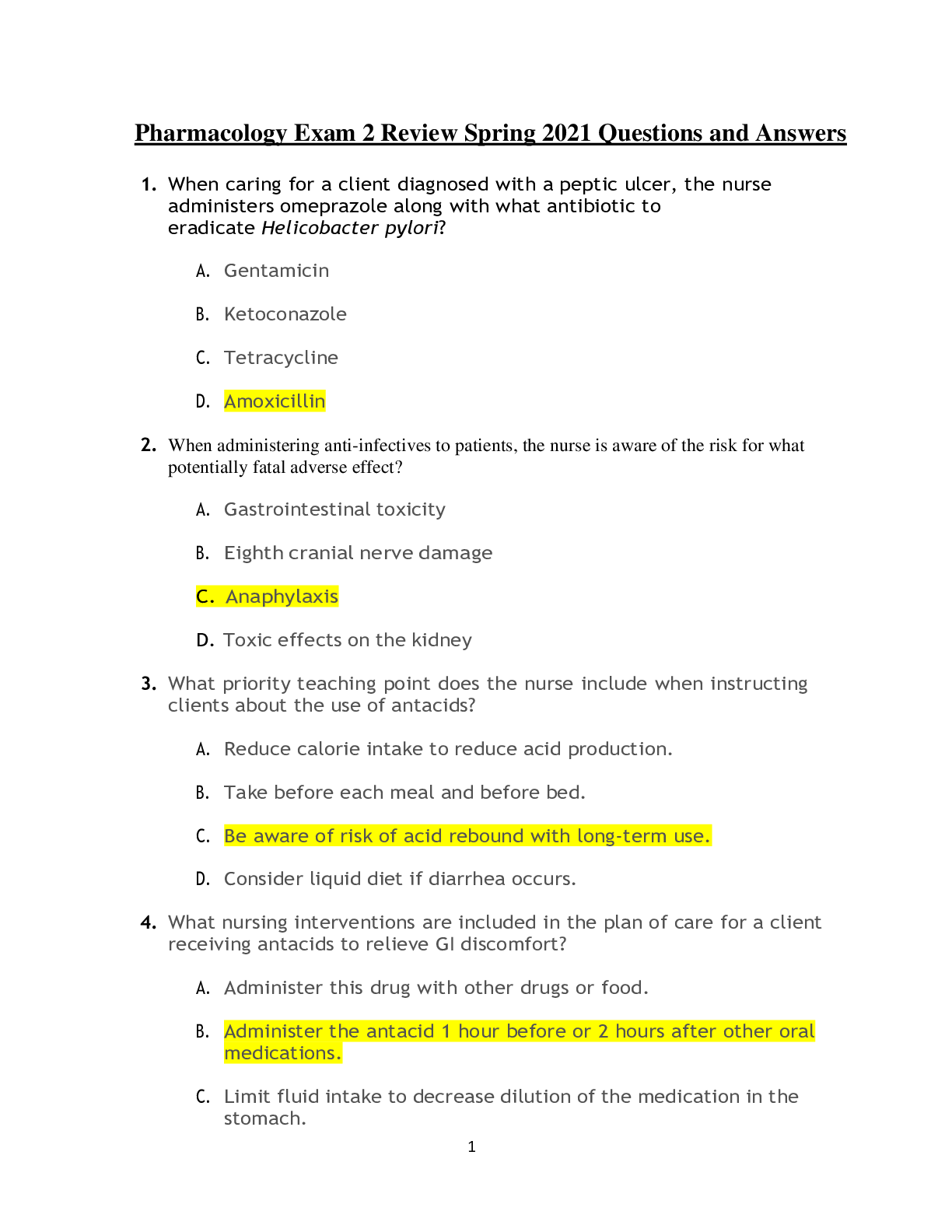
Also available in bundle (1)

(SOLVED) NURSING 3365 Course Map Exam 1&2, EXAM 2 REVIEW WITH EXAM ATTACHED (BUNDLE) 100% GUARANTEED PASS.
(SOLVED) NURSING 3365 Course Map Exam 1&2, EXAM 2 REVIEW WITH EXAM ATTACHED (BUNDLE) 100% GUARANTEED PASS.
By A+ Solutions 2 years ago
$12.5
3
Reviews( 0 )
Document information
Connected school, study & course
About the document
Uploaded On
Sep 20, 2021
Number of pages
13
Written in
Additional information
This document has been written for:
Uploaded
Sep 20, 2021
Downloads
0
Views
65




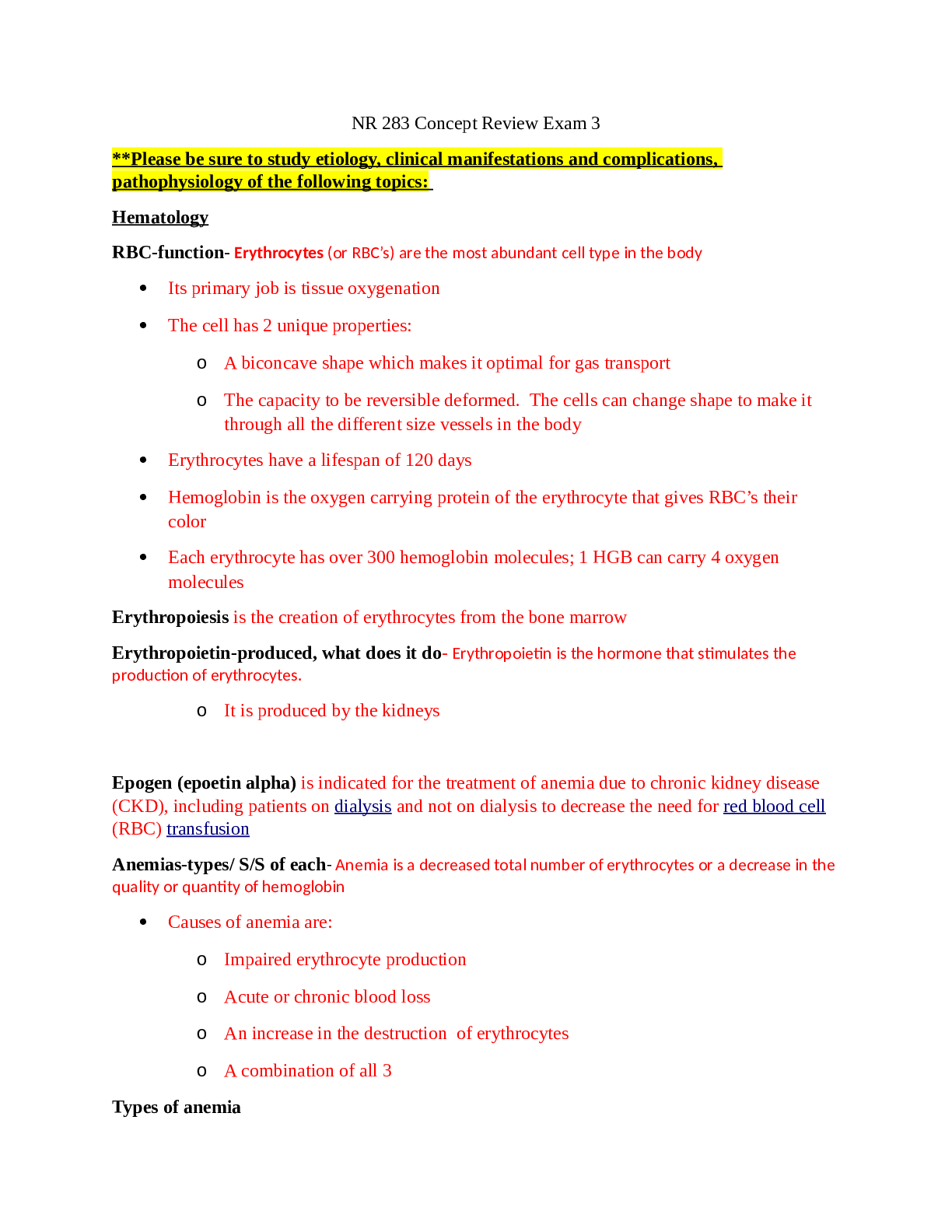
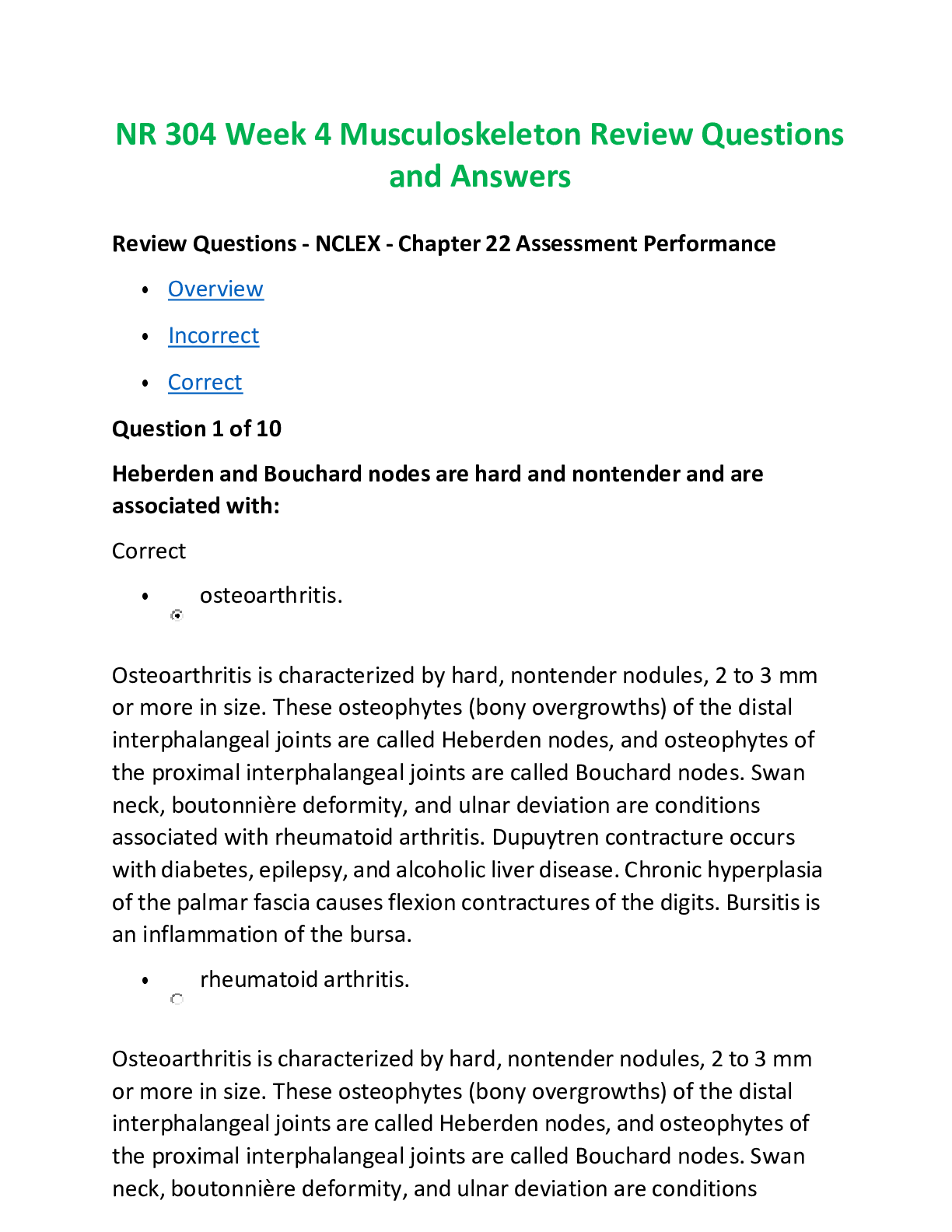

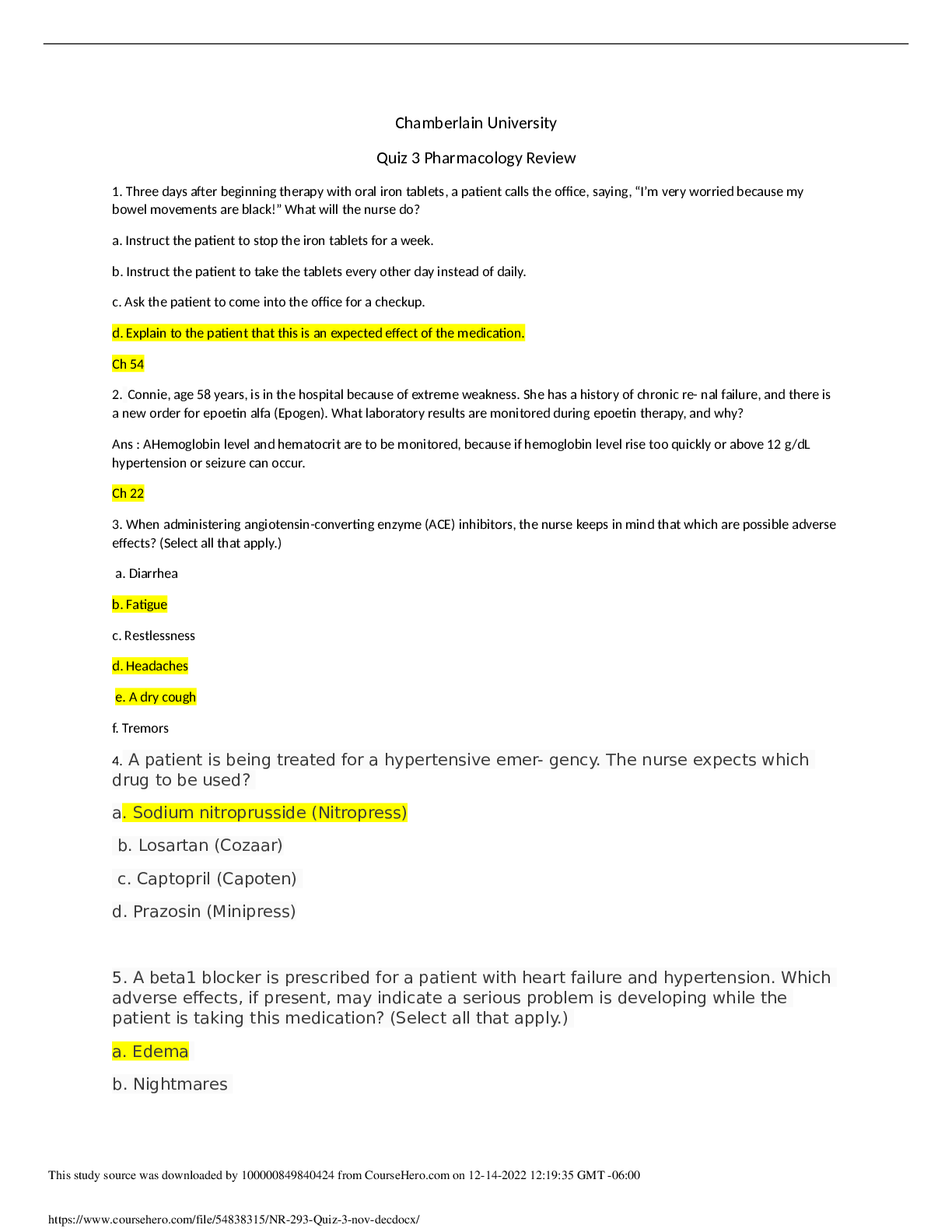

.png)
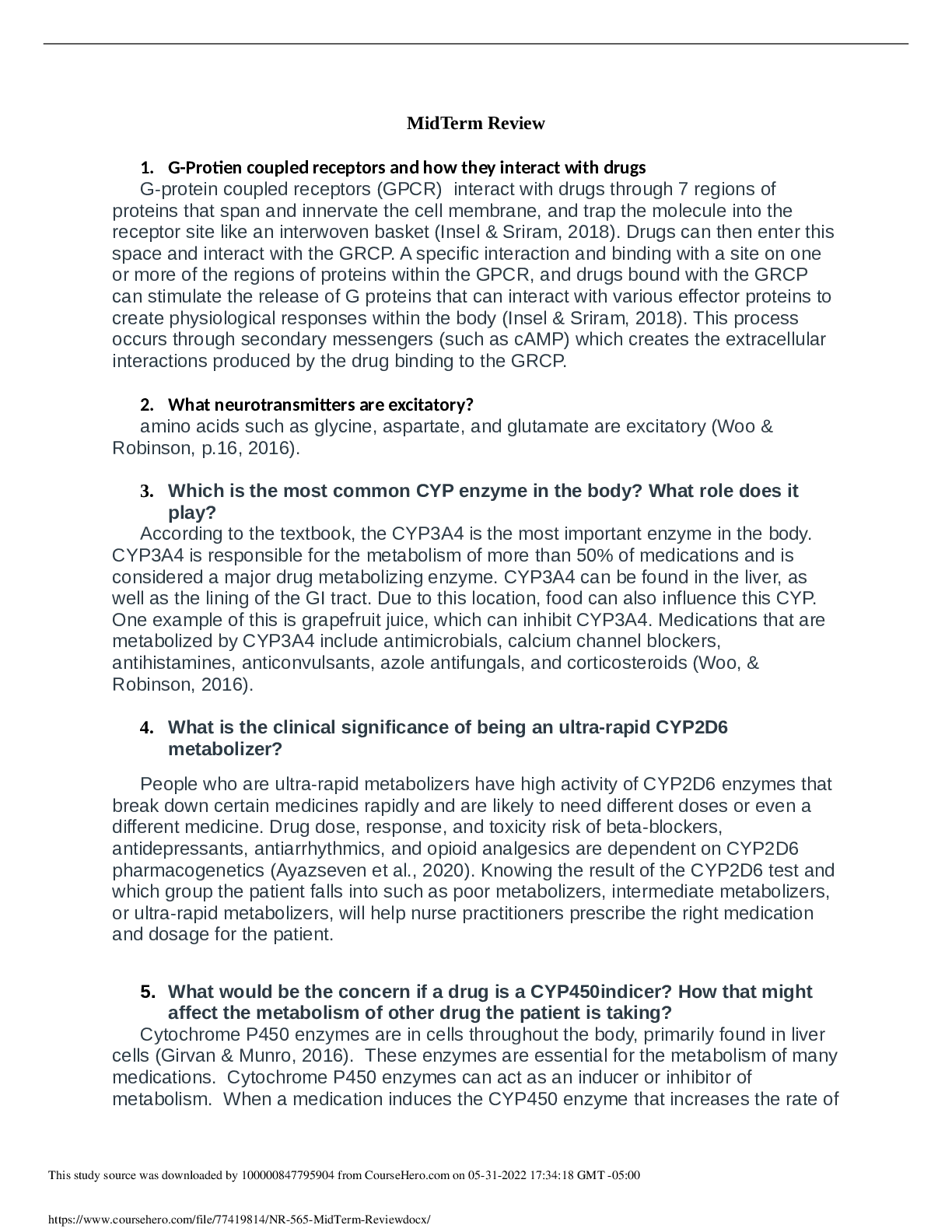
.png)

